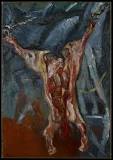Peter Schjeldahl at The New Yorker:
 “Flesh,” the title of a small, potent, and timely Chaim Soutine retrospective, elegantly curated by Stephen Brown, at the Jewish Museum, is genteel. “Meat” would better fit the show’s focus on the ferocious paintings of plucked fowl and bloody animal carcasses that the great and, I believe, underrated Russian-French artist made in the mid-nineteen-twenties, in Paris. Other uses of “meat,” for an argument’s main point or for any solid content, apply as well. The centerpiece of the show, “Carcass of Beef” (circa 1925), on loan from the Albright-Knox Art Gallery, in Buffalo, activates all those meanings. Painted in reds and blues as luminous as those of Gothic stained glass, it communes with Rembrandt’s seventeenth-century masterpiece “The Slaughtered Ox,” which Soutine contemplated often and intensely in the Louvre, and it crackles with formal improvisations (one swift white line rescues a large blue zone from incoherence) and wild emotion. It’s an event—an emergence, an emergency—that transpires ceaselessly while you look. Soutine has long been a marginal figure in modern-art history. Clement Greenberg, in 1951, adjudged his work “exotic” and “futile,” owing to its lack of “reassuring unity” and “decorative ordering.” But today Soutine feels of the moment, amid quite enough reassurance and decorativeness in recent art.
“Flesh,” the title of a small, potent, and timely Chaim Soutine retrospective, elegantly curated by Stephen Brown, at the Jewish Museum, is genteel. “Meat” would better fit the show’s focus on the ferocious paintings of plucked fowl and bloody animal carcasses that the great and, I believe, underrated Russian-French artist made in the mid-nineteen-twenties, in Paris. Other uses of “meat,” for an argument’s main point or for any solid content, apply as well. The centerpiece of the show, “Carcass of Beef” (circa 1925), on loan from the Albright-Knox Art Gallery, in Buffalo, activates all those meanings. Painted in reds and blues as luminous as those of Gothic stained glass, it communes with Rembrandt’s seventeenth-century masterpiece “The Slaughtered Ox,” which Soutine contemplated often and intensely in the Louvre, and it crackles with formal improvisations (one swift white line rescues a large blue zone from incoherence) and wild emotion. It’s an event—an emergence, an emergency—that transpires ceaselessly while you look. Soutine has long been a marginal figure in modern-art history. Clement Greenberg, in 1951, adjudged his work “exotic” and “futile,” owing to its lack of “reassuring unity” and “decorative ordering.” But today Soutine feels of the moment, amid quite enough reassurance and decorativeness in recent art.
more here.
